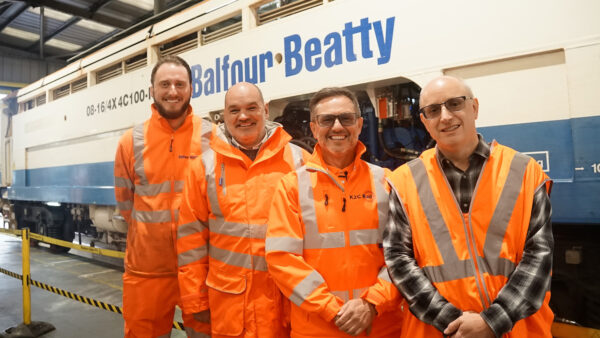HS2 will use colour-coded labels and QR codes to provide full emissions data about plant working on the high-speed rail project, in a bid to make construction sites ‘greener’.
It has become the first infrastructure project to adopt CESAR Emissions Compliance Verification (ECV), the emissions identification scheme.
The new CESAR ECV system is a ‘bolt-on’ product, complementing the existing CESAR security system. The CEA is working with its technical delivery partners, Datatag ID, to deliver the technology behind the ECV Scheme, which powers the database and online portal.
The system allows for quick confirmation of a machine’s emissions by sight thanks to the colour-coded label, whereas previously an operative had to look under the bonnet to find the engine plate to confirm compliance. During site inspection audits, where machinery is in use, this currently means that the machine has to be stopped and cooled, before an inspector can confirm its compliance, which involves costly down-time.
The Construction Equipment Association (CEA) has worked with HS2 over the past year to develop the ECV scheme and is now encouraging the wider construction industry to get on board. HS2’s highlighted the time and cost savings, as well as the health and safety benefits of checking engine plate numbers and provided advice on overcoming challenges regarding retrofit, hybrid and electric equipment. It also looked at on-the-ground practicalities of the scheme on construction sites.
Strict emissions requirements
HS2 has set strict emission requirements for both on- and off-road vehicles and plant that are currently set above the Greater London Authority (GLA) requirements and are extended across Phase One of the project.
HS2 is now recommending the use of the scheme to contractors and supply chains across the project, and a number of contractors are already talking to the CEA about adopting the new scheme.
Manufacturers JCB and Hitachi Construction Equipment have also recently approved the scheme and are now factory fitting the system as standard to all its machines in the UK and Ireland.
HS2’s phase one air quality lead, Andrea Davidson said: “As the country’s largest infrastructure project, we have an opportunity to work with our partners and supply chain to create a greener way of designing and building the new railway. Environmental innovations are at the heart of everything we do – from reducing carbon emissions and using renewable energy on sites; to including eco-friendly features in our designs, creating hundreds of new wildlife habitats along the route, and helping Britain reach our 2050 net zero carbon emissions target.
“It’s also important for us to provide assurances to local authorities and the public that we’re reducing emissions, tightly monitoring air quality and maintaining national air quality standards. The CESAR ECV system is one of many innovations we are supporting, and it’s now our job to embed it in the industry by encouraging our suppliers to use the new scheme as a tool for compliance assurance across all our sites.”
Air quality in focus
Rob Oliver, chief executive of the CEA said: “At the start of 2020 I felt it was going to be a big year for focusing on air quality issues in and around construction. Partly because construction equipment has a great record in reducing potentially harmful emissions and we needed to underline our success story. Partly too because there is some great environmentally friendly technology coming through that the sector needs to know about.
“Now we have all had a taste of the world of lockdown with reduced road travel, we are that little bit more conscious about the quality of the air that we breathe. The ECV initiative builds on a stunningly simple idea that those concerned with monitoring air quality need an easy and visible pointer to the rated emissions of machines on their construction sites. There is no bigger site than the national ribbon of development that is HS2, who have shown great interest in ECV since the get go.”
Comments
Comments are closed.











This project will only benefit a very small portion of the UK public The money could be far better spent on improvement to the whole railway network system In addition in this time of very tight money these nice to do concepts for better green etc will have a very minor impact on reducing greenhouse gases The need is to get the third world to reduce their pollution
But the real need is to reduce the world population